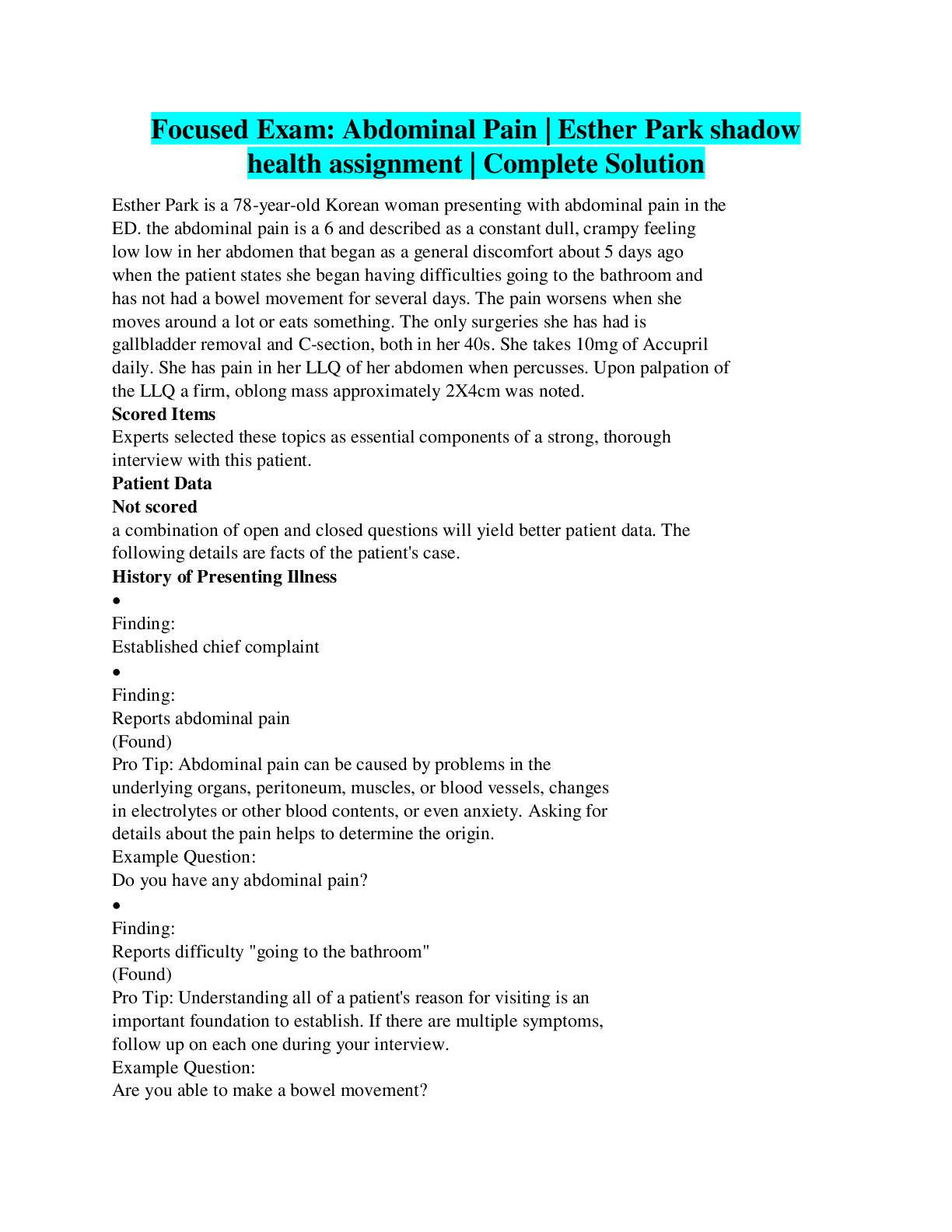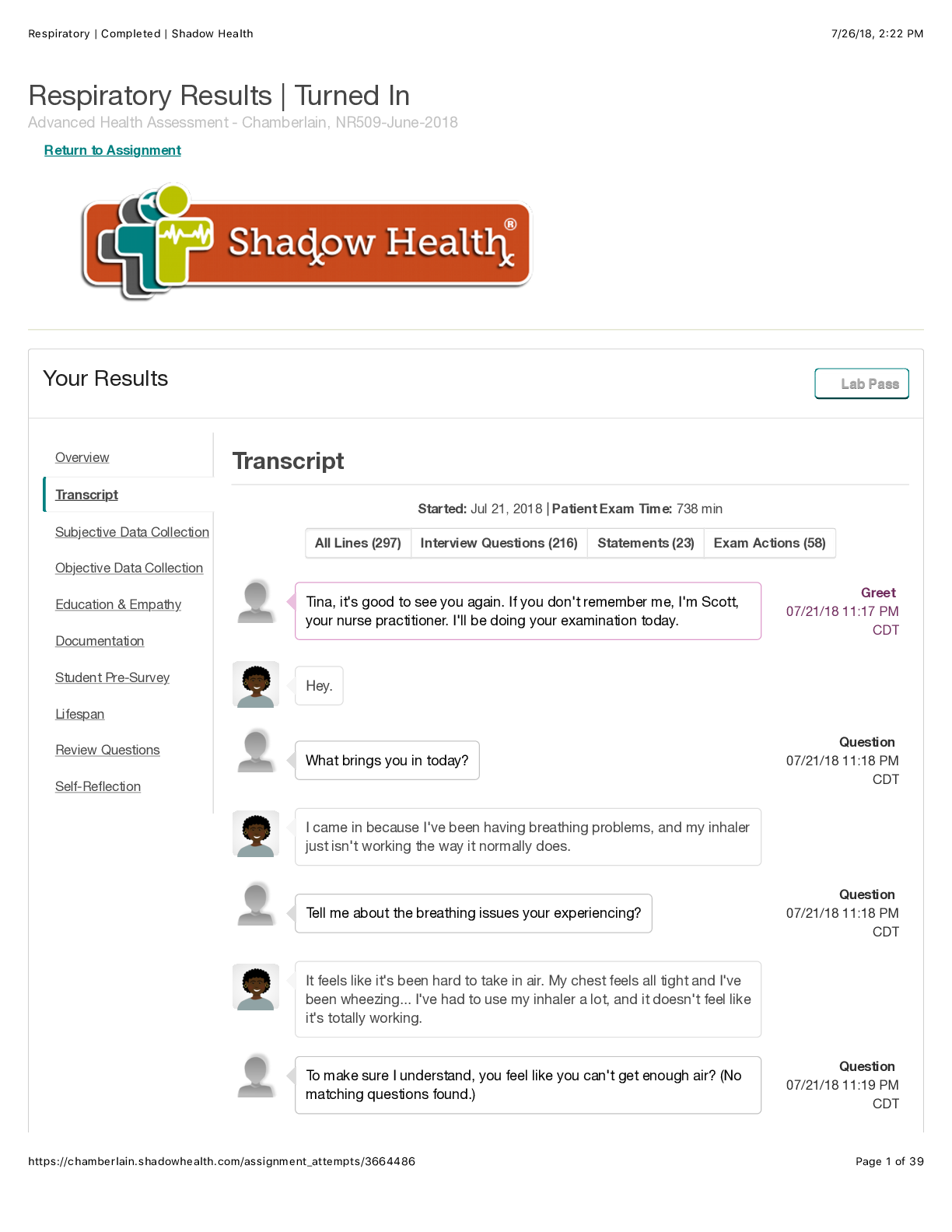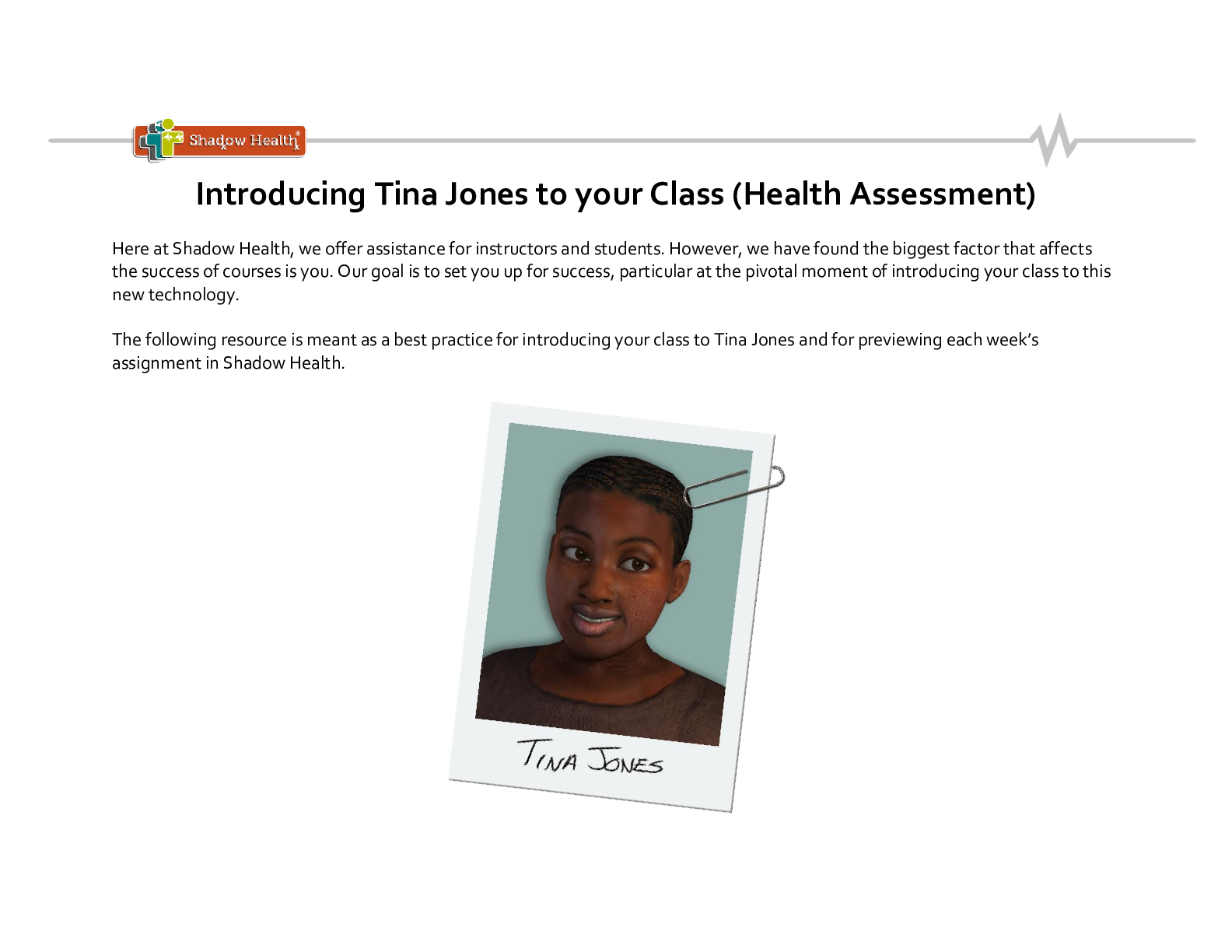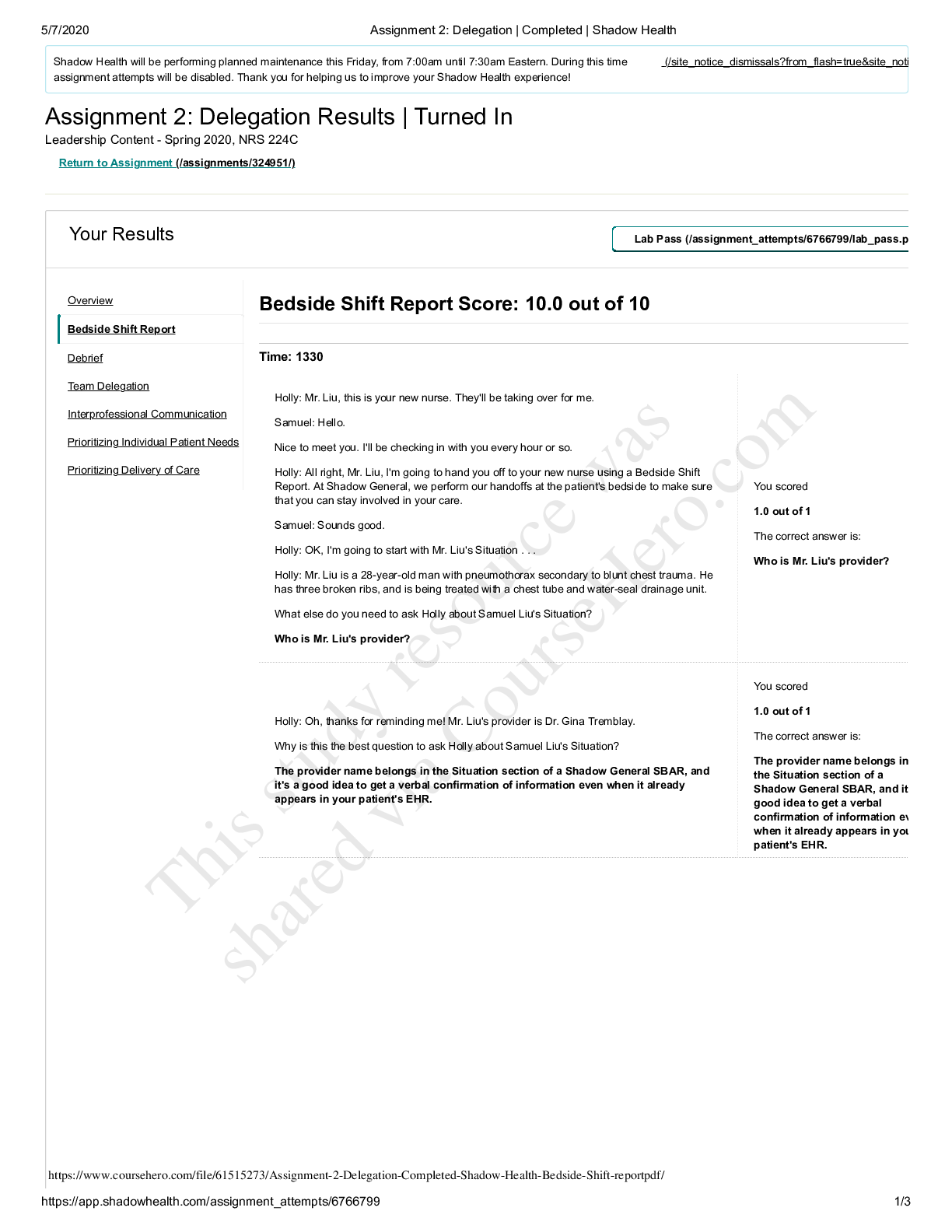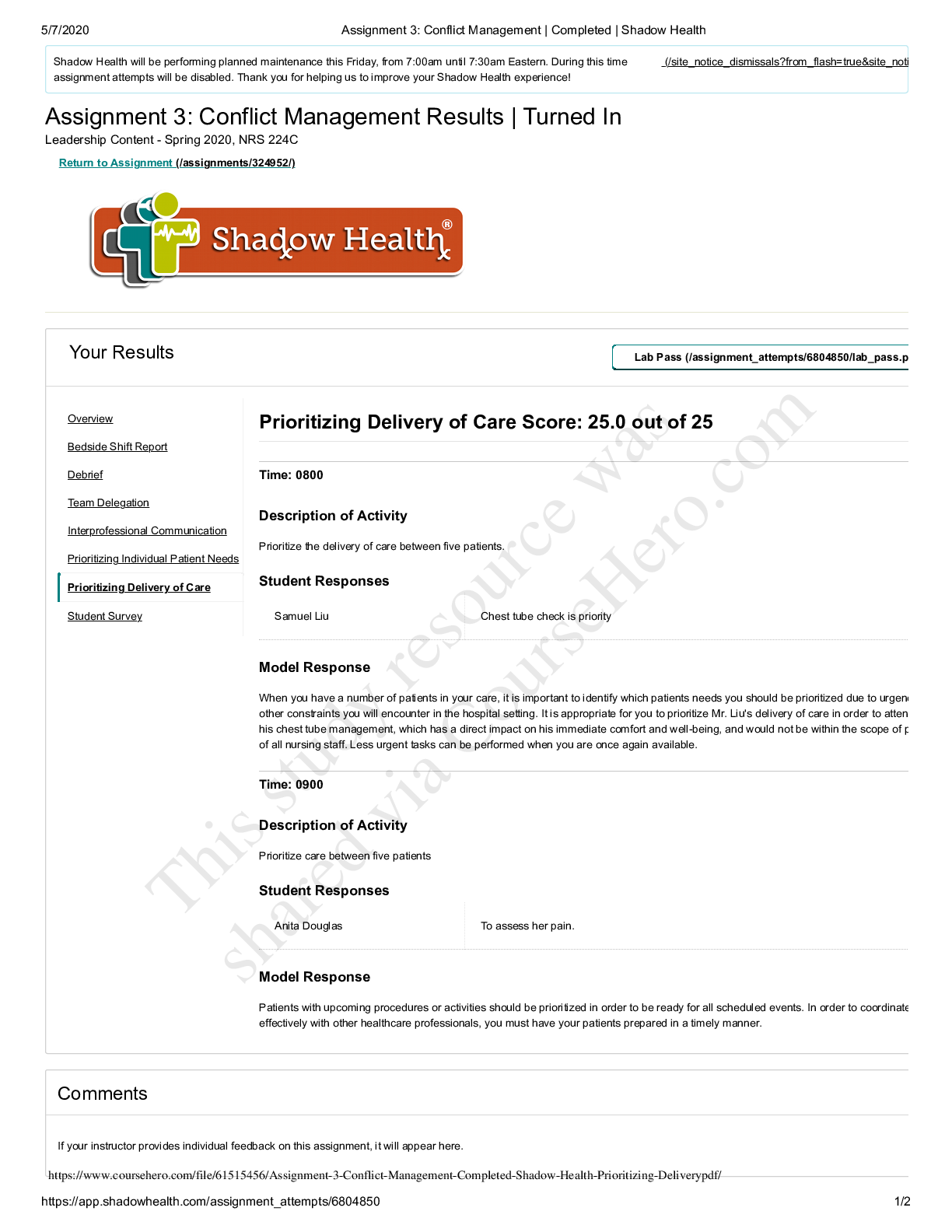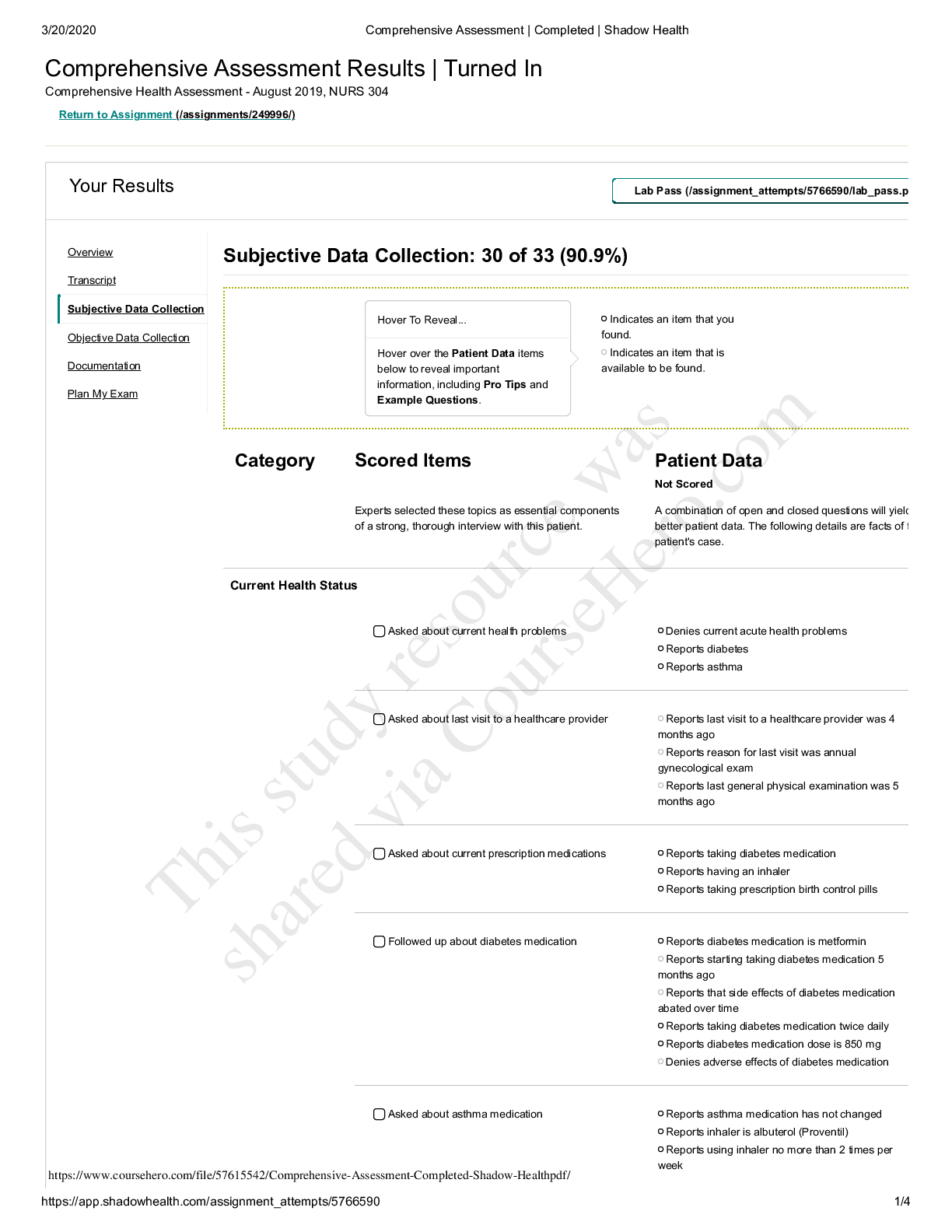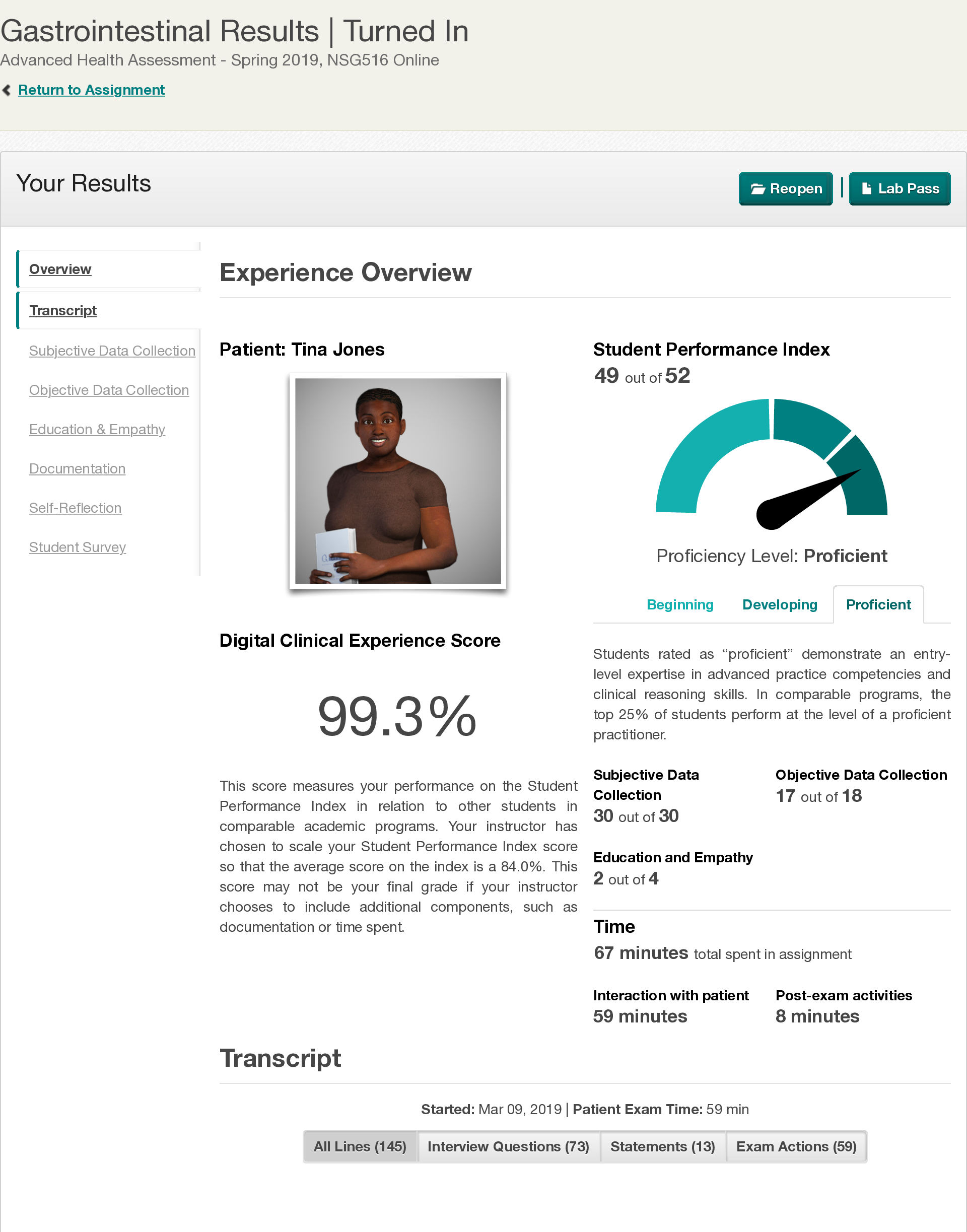*NURSING > SHADOW HEALTH > SHADOW HEALTH HISTORY SUBJECTIVE (All)
SHADOW HEALTH HISTORY SUBJECTIVE
Document Content and Description Below
Subjective Data Collection: 88 of 88 (100.0%) Hover To Reveal... Hover over the Patient Data items below to reveal important information, including Pro Tips and Example Questions. Found: Indicat... es an item that you found. Available: Indicates an item that is available to be found. Category Scored Items Experts selected these topics as essential components of a strong, thorough interview with this patient. Patient Data Not Scored A combination of open and closed questions will yield better patient data. The following details are facts of the patient's case. History of Presenting Illness: Foot Wound Finding: Established chief complaint Finding: Reports pain (Found)Pro Tip: Beginning your conversation with your patient by asking an open- ended question is a best practice for gauging your patient's general condition.Example Question:How severe is the pain? Finding: Reports open foot wound (Found)Pro Tip: If a patient mentions pain, it's important to determine what specifically is causing her pain.Example Question:What's causing your pain? Finding: Asked to rate pain on a scale Finding: Rates present pain at a 7 out of 10 (Found)Pro Tip: Asking your patient to rate her pain on a scale of 0 to 10 is important to gauge how it ebbs and flows while she is in your care.Example Question:Can you rate the pain on a scale of 0 to 10? Finding: Asked for details about the pain Finding: Describes the pain as throbbing (Found)Pro Tip: Determining how your patient describes the characteristics of the pain can be important data to support the cause of the pain.Example Question:Can you please describe the pain? Finding: Describes the pain as sharp when she attempts to stand (Found)Pro Tip: Determining how your patient describes the characteristics of the pain can be important data to support the cause of the pain.Example Question:What is the pain like when you stand on your foot? Finding: Initial injury occurred 1 week ago (Found)Pro Tip: Discovering how long ago the pain began is the first step in understanding whether the pain is chronic or acute.Example Question:When did the pain start? Finding: Pain has increased in the past 2 days (Found)Pro Tip: Finding out how the patient's pain has changed will give you insight into the acceleration of infection.Example Question:How has the pain changed over time? Finding: Reports feeling pain radiating into ankle (Found)Pro Tip: Asking about where else the patient's pain radiates can help determine the progression of infection.Example Question:Does the pain radiate anywhere else? Finding: Pain prevents bearing weight on foot (Found)Pro Tip: Determining if your patient can bear weight on an injury is important to determine their risk for falls while in your care.Example Question:Can you bear weight on your foot? Finding: Clarified location of wound Finding: Confirmed that right foot is injured (Found)Pro Tip: Confirming which extremity an injury is located is a best practice for your patient's safety.Example Question:Which foot is in pain? Finding: Confirmed that wound is on the plantar surface of her foot (Found)Pro Tip: Confirming where a wound is located ensures you are aware of your patient's biggest complaint.Example Question:Where is the wound? Finding: Determined details of the injury Finding: Scraped foot on bottom rung of a step stool (Found)Pro Tip: Discovering how an injury happened helps to assess your patient's risk factors for injury.Example Question:How did your injury happen? Finding: Reports no other injuries besides foot wound (Found)Pro Tip: Discovering additional injuries can reveal more information about the circumstances that caused the presenting injury.Example Question:Did you injure anything besides your foot? Finding: Was not drinking at the time of the injury (Found)Pro Tip: Finding out if alcohol is involved in an injury can give you insight into a patient's potential substance abuse, and can uncover aggravating factors.Example Question:Did you have any alcoholic drinks before your injury? Finding: Was not wearing shoes at the time of injury (Found)Pro Tip: Asking about clothing, footwear, and other protective elements being worn at the time of injury helps you discover the totality of the circumstances.Example Question:Were you wearing shoes when you fell? Finding: Has not seen a healthcare provider for the injury (Found)Pro Tip: It's crucial to ask whether your patient has seen another provider for the injury, because any previous medical intervention will help you understand the progression of the wound.Example Question:Have you seen a healthcare provider for this injury? Finding: Asked about drainage from the foot wound Finding: Reports that the wound bled a little after sustaining the injury (Found)Pro Tip: Asking about bleeding helps you determine the characteristics of a wound.Example Question:Did your foot bleed? Finding: Reports seeing pus draining from wound (Found)Pro Tip: Asking about discharge helps you determine the characteristics of a wound.Example Question:Did you notice any discharge from the wound? Finding: Began noticing pus 2 days ago (Found)Pro Tip: Pinpointing exactly when the patient noticed the arrival of pus gives you an important data point for when an active infection began.Example Question:When did you first notice the pus? Finding: Followed up about character of drainage from the foot wound Finding: Describes pus as white or yellow in color (Found)Pro Tip: The color of discharge from a wound can provide insight into its severity and characteristics.Example Question:What color is the drainage from your wound? Finding: Reports no odor from the wound (Found)Pro Tip: The odor of discharge from a wound can provide insight into its severity and characteristics.Example Question:Does the wound have an odor? Finding: Asked about home treatment of foot wound Finding: Describes wound care regimen of cleaning and bandaging (Found)Pro Tip: Listening to a patient's wound care routine provides insight into the history of the wound, as well as the patient's health literacy.Example Question:How did you treat your foot at home? Finding: Cleaned wound twice a day (Found)Pro Tip: Asking specifically how often a patient cleaned a wound will let you know if an infection spread through improper hygiene, or for other reasons such as uncontrolled blood sugar.Example Question:How often did you clean the wound? Finding: Cleaned wound with hydrogen peroxide (Found)Pro Tip: Determining what products a patient used to clean a wound provides insight into the history of the wound, as well as the patient's health literacy.Example Question:What did you use to clean the wound? Finding: Changed bandage twice a day (Found)Pro Tip: Asking specifically how often a patient changed a bandage will let you know if an infection spread through improper hygiene, or for other reasons such as uncontrolled blood sugar.Example Question:How often do you change your bandage? Finding: Applied neosporin (Found)Pro Tip: Determining what products a patient used to sterilize or treat a wound establishes home care routines and health literacy.Example Question:Did you use any ointment on the wound? Finding: Asked about other foot wound symptoms Finding: Reports swelling around foot wound (Found)Pro Tip: Asking about the presence of swelling helps you gather information about your patient's complaint, as well as potential related illnesses.Example Question:Is there swelling around the wound? Finding: Noticed swelling getting worse in the past 2 days (Available)Pro Tip: Finding out how long swelling appeared will help you understand the timeline for the infection progression.Example Question:How long have you noticed swelling around the wound? Finding: Reports redness around the wound (Found)Pro Tip: Asking about redness will help you understand the timeline for the infection progression.Example Question:Did you notice any redness around the wound? Finding: Reports that the wound feels warm (Found)Pro Tip: Asking about warmth will help you understand the timeline for the infection progression.Example Question:Does the wound feel warm? Finding: Explored impact of patient's foot injury on activities of daily living Finding: Pain affects ability to walk (Available)Pro Tip: Learning the impact of your patient's wound on daily activities helps inform your plan for care.Example Question:Does your injury impact your ability to walk? Finding: Pain affects job performance (Available)Pro Tip: Learning how severely the wound has interfered with an essential aspect of daily life, and can uncover a source of stress for the patient.Example Question:Does your foot pain affect your work? Finding: Pain prevented her from attending class (Available)Pro Tip: For patients who are also students, you can find out what schoolwork they are missing, and help them make accommodations so they don't fall behind.Example Question:Has your injury prevented you from going to class? Finding: Asked about recent fever Finding: Reports recent feverish episode (Found)Pro Tip: The presence or absence of fever can indicate if an infection is approaching sepsis, a life-threatening condition.Example Question:Are you feeling feverish right now? Past Medical History: Diabetes Finding: Asked details about diabetes diagnosis Finding: Diagnosed as an adult (Found)Pro Tip: Learning the diagnosis date of your patient's illness is an essential element of the illnesses history.Example Question:When were you diagnosed with diabetes? Finding: Specific age of diagnosis is 24 years old (Found)Pro Tip: Learning the diagnosis date of your patient's illness is an essential element of the illnesses history.Example Question:At what age were you diagnosed with diabetes? Finding: Reports that her diabetes is Type 2 (Found)Pro Tip: The type of diabetes your patient has will drastically affect how you care for her, Example Question:Do you know what type of diabetes you have? Finding: Asked about diabetes management through diet Finding: Reports that she tries to manage diabetes with diet (Found)Pro Tip: Understanding how your patient cares for her diabetes is an essential element to learning the history of her illness.Example Question:Do you follow a diabetic diet? Finding: Reports "staying away from sweets" (Found)Pro Tip: Asking your patient specifically about sugar intake can help you understand the history of her diabetes as well as her health literacy.Example Question:Tell me more about any sugars you consume. Finding: Reports drinking diet coke instead of regular (Available)Pro Tip: Particularly for diabetic patients, asking about intake of drinks that contain sugar can reveal additional sources of carbohydrates that the patient may not consider.Example Question:Do you drink sugary drinks? Finding: Asked about current diabetes medication use Finding: Does not currently take medication for diabetes (Found)Pro Tip: Asking about diabetes medication is important to understanding if your patient's disease is under control.Example Question:Do you take prescribed medication for your diabetes? Finding: Asked about past diabetes medication use Finding: Used to take diabetes medication (Found)Pro Tip: Asking about diabetes medication is important to understanding if your patient's disease is under control.Example Question:Have you ever taken medication for your diabetes? Finding: Previous medication was prescription metformin (Found)Pro Tip: Asking about diabetes medication is important to understanding if your patient's disease is under control.Example Question:Do you remember what you were prescribed for diabetes? Finding: Last use of medication was 3 years ago (Found)Pro Tip: Asking about diabetes medication is important to understanding if your patient's disease is under control.Example Question:When was the last time you took your diabetes medication on a regular basis? Finding: Explored the reasons the patient stopped her diabetes regimen Finding: Reports that she "got sick of dealing with it" (Found)Pro Tip: Asking reasons for noncompliance can reveal information about your patient's health literacy, side effects, financial situation, and more.Example Question:Why aren't you taking your diabetes medication? Finding: Reports disliking metformin side effects (Found)Pro Tip: Asking about side effects from medication can provide information about your patient's reaction to treatment. Example Question:Did the metformin cause any side effects? Finding: Describes that she didn't like checking sugar and taking daily pills (Found)Pro Tip: Asking reasons for noncompliance can reveal information about your patient's health literacy, side effects, financial situation, and more.Example Question:What's preventing you from taking your diabetes medication? Finding: Asked about blood glucose monitoring [Show More]
Last updated: 2 years ago
Preview 1 out of 27 pages
Buy this document to get the full access instantly
Instant Download Access after purchase
Buy NowInstant download
We Accept:

Reviews( 0 )
$10.00
Can't find what you want? Try our AI powered Search
Document information
Connected school, study & course
About the document
Uploaded On
Jun 09, 2021
Number of pages
27
Written in
Additional information
This document has been written for:
Uploaded
Jun 09, 2021
Downloads
0
Views
114





